
Varanus caudolineatus – BOULENGER, 1885
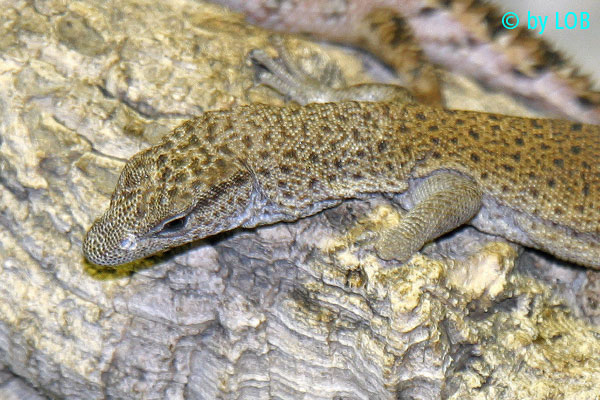
Varanus caudolineatus: Adult male, missing all toes of left front foot except thumb, but showing hardly any functional defects • Adultes Männchen, dem mit nur geringer Funktionseinschränkung bis auf den Daumen alle Zehen des linken Vorderfußes fehlen.
© Lutz Obelgönner
© Lutz Obelgönner
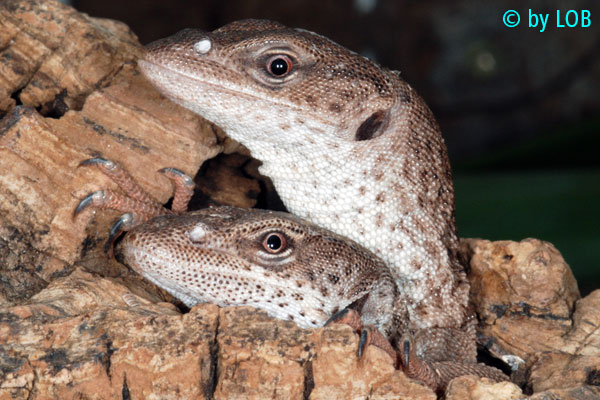
Varanus caudolineatus: Adult captive-bred pair • Adultes Nachzuchtpärchen
© Lutz Obelgönner
© Lutz Obelgönner
Line-tailed Pigmy Monitor
Description
Belongs to the dwarf monitors of the subgenus Odatria. The name refers to the characteristic lines on the tail and comes from the Latin words caudus = 'tail' and lineatus = 'lined'. Grey-brownish back with small dots, some populations also grey-golden. One of the smallest monitor species which is bred only in small numbers; arboreal, easy to maintain. Some animals prefer to stay hidden in their retreats most of the time. In some areas Varanus caudolineatus shares the mulga trees of the scrubland with Egernia depressa. Then the monitors normally live on and in the branches, the skinks in the hollow stems.
Protection
EU Directive 338/97, Appendix B
Adult Size
up to 30 cm in captive-bred animals, much smaller in nature
Lifespan
at least 15 years
Distribution
only Western Australia from the Pilbara to the southern Gascoyne Region
Habitat
dead and live trees (acacia, casuarina oaks) in different areas, beneath loose bark and in hollow limbs of trees, on rangeland stakes
Captive Care
Cage 60x60x60 cm WDH, better more. This species needs a retreat, e. g. plants or cork tubes. Cover the back with cork or bark to maximize climbing opportunities. Day temperature 26–28 °C, local spot 40 °C, night temperature 18–22 °C, humidity 50–60 %. Daylight fluorescent lamps or LEDs, HQL or other source of UV, substrate sand/clay mix, water bowl, climbing branches. Spray from time to time.
Food
all kinds of insects and their larvae, minerals/vitamins (e. g. Herpetal Complete)
Reproduction and Rearing
Groups possible, possibly cooler phase to imply winter. 2–5 eggs laid in substrate or nesting box, 2–3 clutches per year possible. Incubation at 29 °C for 85–120 days. Don’t incubate too wet. Rearing on small insects plus vitamins/minerals easy. Separate youngs if they start to fight.
Belongs to the dwarf monitors of the subgenus Odatria. The name refers to the characteristic lines on the tail and comes from the Latin words caudus = 'tail' and lineatus = 'lined'. Grey-brownish back with small dots, some populations also grey-golden. One of the smallest monitor species which is bred only in small numbers; arboreal, easy to maintain. Some animals prefer to stay hidden in their retreats most of the time. In some areas Varanus caudolineatus shares the mulga trees of the scrubland with Egernia depressa. Then the monitors normally live on and in the branches, the skinks in the hollow stems.
Protection
EU Directive 338/97, Appendix B
Adult Size
up to 30 cm in captive-bred animals, much smaller in nature
Lifespan
at least 15 years
Distribution
only Western Australia from the Pilbara to the southern Gascoyne Region
Habitat
dead and live trees (acacia, casuarina oaks) in different areas, beneath loose bark and in hollow limbs of trees, on rangeland stakes
Captive Care
Cage 60x60x60 cm WDH, better more. This species needs a retreat, e. g. plants or cork tubes. Cover the back with cork or bark to maximize climbing opportunities. Day temperature 26–28 °C, local spot 40 °C, night temperature 18–22 °C, humidity 50–60 %. Daylight fluorescent lamps or LEDs, HQL or other source of UV, substrate sand/clay mix, water bowl, climbing branches. Spray from time to time.
Food
all kinds of insects and their larvae, minerals/vitamins (e. g. Herpetal Complete)
Reproduction and Rearing
Groups possible, possibly cooler phase to imply winter. 2–5 eggs laid in substrate or nesting box, 2–3 clutches per year possible. Incubation at 29 °C for 85–120 days. Don’t incubate too wet. Rearing on small insects plus vitamins/minerals easy. Separate youngs if they start to fight.
Schwanzstrichwaran
Generelles
Gehört zu den Zwergwaranen der Untergattung Odatria. Benannt nach der charakteristischen Streifenzeichnung des Schwanzes. Die lateinischen Wörter caudus = Schwanz und lineatus = gestreift spielen Pate. Oberseite graubraun mit feinen Flecken, in manchen Populationen auch grau-golden. Einer der kleinsten Warane der Welt mit sehr angenehmem Verhalten, der leider nur in kleinen Stückzahlen nachgezüchtet wird. Baumbewohnend, gut zu halten, aber manche Tiere befinden sich die meiste Zeit in ihren Versteckplätzen. In manchen Gegenden teilt sich Varanus caudolineatus die Bäume des Mulga-Buschlandes mit Egernia depressa. Dann leben die Warane meist auf den Ästen, die Skinke in den hohlen Baumstämmen.
Schutzstatus
EU-Verordnung 338/97, Anhang B
Größe
als Nachzucht maximal 30 cm, in der Natur meist viel kleiner
Lebenserwartung
mindestens 15 Jahre
Vorkommen
nur Western Australia von der Pilbara bis zur südlichen Gascoyne Region
Habitat
tote und lebende Bäume in unterschiedlichsten Gebieten, unter Rinde (Akazien, Casuarina) und in hohlen Ästen, an Weidepfählen
Haltung
Terrarium 60x60x60 cm BTH, besser mehr. Viel Deckung, z. B. Pflanzen, Korkröhren. Rückwand mit Rinde bekleben, um Kletterfläche zu vergrößern. Lufttemperatur tags etwa 26–28 °C, unter Strahler 40 °C, nachts 18–22 °C, Luftfeuchtigkeit 50–60 %. Tageslichtleuchtstoffröhren oder LEDs, HQL oder andere UV-Quelle, Boden Lehm-Sand-Gemisch, Kletteräste, Wassergefäß. Ab und zu sprühen.
Futter
Insekten jeder Art und ihre Larven, Mineralien/Vitamine (z. B. Herpetal Complete)
Zucht und Aufzucht
Gruppenhaltung möglich, evtl. kühlere Phase, um Winter anzudeuten. 2–5 Eier, mehrere Gelege möglich. Ablage in Nestbox oder Bodengrund. 85–120 Tage Inkubation bei 28 °C. Nicht zu feucht inkubieren. Aufzucht mit kleinen Insekten plus Vitamin-Mineralpulver unproblematisch. Jungtiere trennen, falls Streitereien beobachtet werden.
Gehört zu den Zwergwaranen der Untergattung Odatria. Benannt nach der charakteristischen Streifenzeichnung des Schwanzes. Die lateinischen Wörter caudus = Schwanz und lineatus = gestreift spielen Pate. Oberseite graubraun mit feinen Flecken, in manchen Populationen auch grau-golden. Einer der kleinsten Warane der Welt mit sehr angenehmem Verhalten, der leider nur in kleinen Stückzahlen nachgezüchtet wird. Baumbewohnend, gut zu halten, aber manche Tiere befinden sich die meiste Zeit in ihren Versteckplätzen. In manchen Gegenden teilt sich Varanus caudolineatus die Bäume des Mulga-Buschlandes mit Egernia depressa. Dann leben die Warane meist auf den Ästen, die Skinke in den hohlen Baumstämmen.
Schutzstatus
EU-Verordnung 338/97, Anhang B
Größe
als Nachzucht maximal 30 cm, in der Natur meist viel kleiner
Lebenserwartung
mindestens 15 Jahre
Vorkommen
nur Western Australia von der Pilbara bis zur südlichen Gascoyne Region
Habitat
tote und lebende Bäume in unterschiedlichsten Gebieten, unter Rinde (Akazien, Casuarina) und in hohlen Ästen, an Weidepfählen
Haltung
Terrarium 60x60x60 cm BTH, besser mehr. Viel Deckung, z. B. Pflanzen, Korkröhren. Rückwand mit Rinde bekleben, um Kletterfläche zu vergrößern. Lufttemperatur tags etwa 26–28 °C, unter Strahler 40 °C, nachts 18–22 °C, Luftfeuchtigkeit 50–60 %. Tageslichtleuchtstoffröhren oder LEDs, HQL oder andere UV-Quelle, Boden Lehm-Sand-Gemisch, Kletteräste, Wassergefäß. Ab und zu sprühen.
Futter
Insekten jeder Art und ihre Larven, Mineralien/Vitamine (z. B. Herpetal Complete)
Zucht und Aufzucht
Gruppenhaltung möglich, evtl. kühlere Phase, um Winter anzudeuten. 2–5 Eier, mehrere Gelege möglich. Ablage in Nestbox oder Bodengrund. 85–120 Tage Inkubation bei 28 °C. Nicht zu feucht inkubieren. Aufzucht mit kleinen Insekten plus Vitamin-Mineralpulver unproblematisch. Jungtiere trennen, falls Streitereien beobachtet werden.
Literature / Literatur
Brown, Danny (2012). A Guide to Australian Monitors in Captivity. Reptile Publications, Burleigh/QLD.
Eidenmüller, Bernd (2007). Small monitors in the terrarium. Reptilia (English edition) (50): 12–19. Barcelona.
Eidenmüller, Bernd (2007). Kleinwarane im Terrarium. Reptilia 12 (1): 16–23. NTV, Münster.
Eidenmüller, Bernd (2009). Warane – Lebensweise • Pflege • Zucht. Herpeton, Offenbach.
Kirschner, Andreas, Thomas Müller & Hermann Seufer (1996). Warane: Pflege und Zucht. Kirschner & Seufer Verlag, Keltern-Weiler.
Pianka, Eric R. (2003). Die Warane der australischen Wüste. Reptilia 8 (5): 29–35. NTV, Münster.
Pianka, Eric R. (2003). Australian Desert Varanids. Reptilia (English edition) (30): 20–26. Barcelona.
Brown, Danny (2012). A Guide to Australian Monitors in Captivity. Reptile Publications, Burleigh/QLD.
Eidenmüller, Bernd (2007). Small monitors in the terrarium. Reptilia (English edition) (50): 12–19. Barcelona.
Eidenmüller, Bernd (2007). Kleinwarane im Terrarium. Reptilia 12 (1): 16–23. NTV, Münster.
Eidenmüller, Bernd (2009). Warane – Lebensweise • Pflege • Zucht. Herpeton, Offenbach.
Kirschner, Andreas, Thomas Müller & Hermann Seufer (1996). Warane: Pflege und Zucht. Kirschner & Seufer Verlag, Keltern-Weiler.
Pianka, Eric R. (2003). Die Warane der australischen Wüste. Reptilia 8 (5): 29–35. NTV, Münster.
Pianka, Eric R. (2003). Australian Desert Varanids. Reptilia (English edition) (30): 20–26. Barcelona.
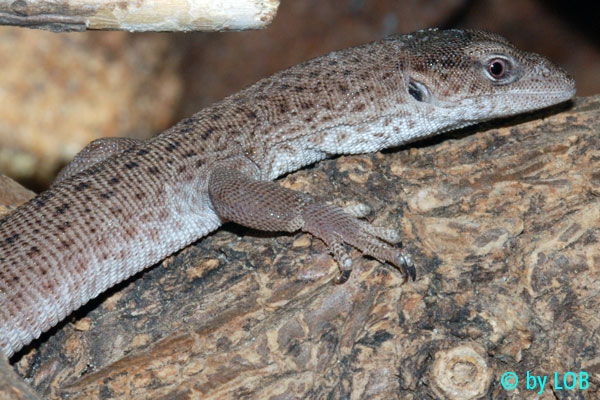
Varanus caudolineatus: Adult captive-bred female • Adultes Nachzuchtweibchen
© Lutz Obelgönner
© Lutz Obelgönner
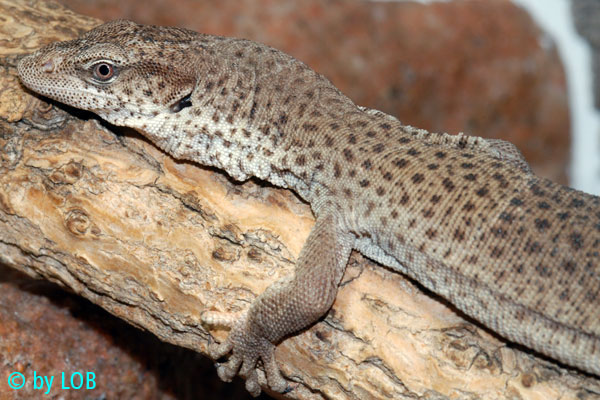
Varanus caudolineatus: Adult captive-bred male • Adultes Nachzuchtmännchen
© Lutz Obelgönner
© Lutz Obelgönner
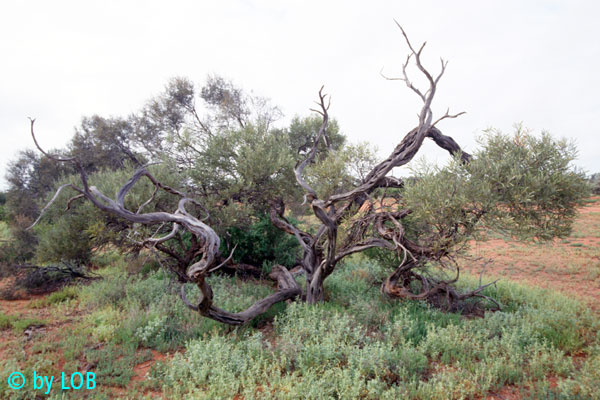
Varanus caudolineatus: Habitat of this species in mulga scrubland (Western Australia) • Habitat der Art im Mulga-Buschland in Western Australia
© Lutz Obelgönner
© Lutz Obelgönner
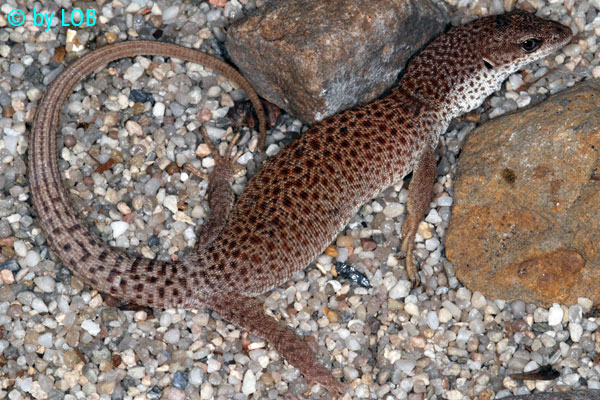
Varanus caudolineatus: Captive-bred juvenile, six months old • Nachzuchttier, sechs Monate alt
© Lutz Obelgönner
© Lutz Obelgönner